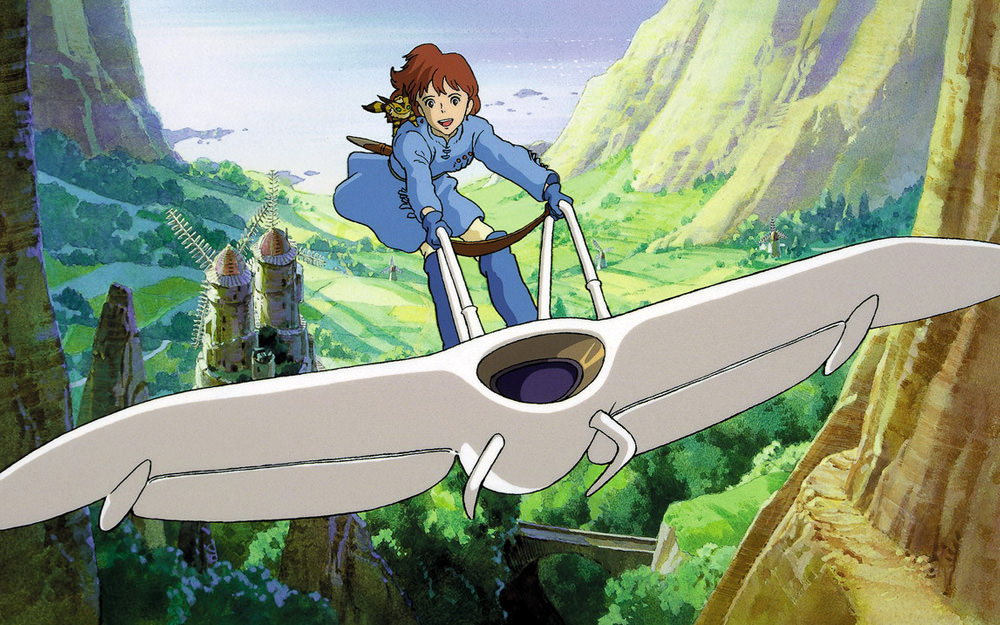
Far in the distant future, a thousand years after a war known as “The Seven Days of Fire” destroyed most of the human race, the earth is ravaged by “The Sea of Decay,” a poisonous forest populated by monstrous insects. The Sea threatens to spread over the entire planet. However, the small, peaceful Valley of the Wind has so far managed to remain outside its reach, the wind from the nearby ocean protecting it from the Sea’s poisonous spores.
The Valley’s most beloved citizen is their princess, Nausicaä, a young woman who, despite her age, is already a skilled warrior and pilot. She’s also somewhat of a scientist, researching the Sea and its inhabitants and trying to figure out a way to cleanse its corruption.
However, all of her attempts at peace and healing are threatened when an aircraft from the kingdom of Tolmekia crashes in the valley, bringing with it the Sea’s spores and something else, a deadly cargo Tolmekia hopes will destroy the Sea. Shortly thereafter, Tolmekia’s armies, led by the Princess Kushana, invade the Valley in an attempt to recover the cargo and unite any countries in their battle against the Sea.
Meanwhile, the country of Pejite rises up against Tolmekia, seeking to take their discovery — the remains of a “giant soldier,” a massive robot-like creature which nearly destroyed mankind during The Seven Days Of Fire — and use it against Tolmekia. Not surprisingly, the Sea doesn’t take too kindly to all of this commotion. Soon, massive armies of “ohmu” — giant armored insects — are streaming out of the Sea, threatening to consume all of humanity unless Nausicaä can figure out a way to put an end to the destruction.
If you’ve seen any of Hayao Miyazaki’s other films, than you might be asking yourself “Haven’t I already seen this?” while reading the above synopsis. Indeed, watching Nausicaä of the Valley of the Wind is almost like a case of deja vu. And the reason is that Nausicaä of the Valley of the Wind is the quintessential, archetypal Miyazaki film. All of the components that are so prevalent in his movies — young, strong-willed heroines, environmental issues, a fascination with pastoral European settings, amazing aerial sequences, etc. — can basically be traced back to this one single movie.
In that regards, Nausicaä of the Valley of the Wind is the essential Miyazaki movie. However, it’s over two decades old, and in many ways, it shows its age. As with everything else Miyazaki has made, the movie is full of lush, verdant visuals and mind-boggling environments. However, compared to the spectacles of his later films, especially Princess Mononoke (which very closely parallels Nausicaä of the Valley of the Wind), this film feels a bit lacking.
One aspect that I’ve always found so fascinating about Miyazaki’s movies, and which seemed rather diminished in Nausicaä of the Valley of the Wind, are the moral shadings and ambiguities of his characters. Compared to the complex characters and situations in some of his other films, Nausicaä of the Valley of the Wind seems quite simplistic. Nausicaä herself is quite saintly, and her only real antagonist, Kushana, is never quite given the same amount of moral depth as someone like Princess Mononoke’s Lady Eboshi or Spirited Away’s Haku.
I suspect much of this has to do with the fact that Miyazaki adapted the movie from his epic manga series of the same name. There’s simply no way that he could’ve packed the entire series, which runs well over 1,000 pages, into a single 2-hour movie. Having read the manga about a year ago, I was quite surprised at just how much was changed or left out entirely. Much of the series’ cultural and religious/mystical content was removed, and many scenes were simply altered entirely. As a result, the movie’s plot never quite seems to hit its stride, though viewers who don’t have the manga series running in the back of their mind might feel differently.
I know that most devoted Miyazaki fans have probably seen Nausicaä of the Valley of the Wind already, or are going to add this to their collection simply because it is a Hayao Miyazaki movie (which is what I did). In some ways, the film just hasn’t aged very well, and since then, Miyazaki has made several films, such as the aforementioned Princess Mononoke, which more completely and thoroughly explore his trademark themes.
However, Nausicaä of the Valley of the Wind is worth watching if only to give one a much better context in which to appreciate Miyazaki’s movies. It’s impossible to watch this film and not see the seeds of Miyazaki’s distinguished career, of his considerable talent at creating worlds of powerful imagination and story-telling. I doubt most people will argue with the statement that Miyazaki is one of the world’s greatest animations, alive or dead. And Nausicaä of the Valley of the Wind allows one to better grasp and understand just why that is the case.
